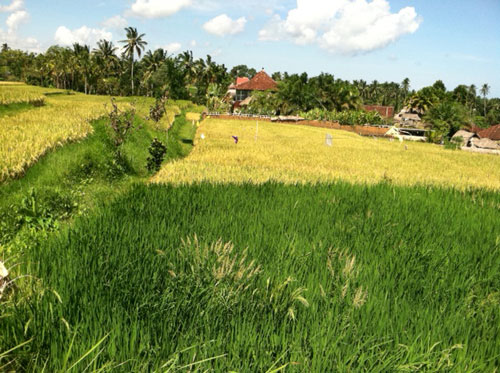Editor's Note by Martha Nichols
Creating the World Inside My Head
I didn't love Bali until I was leaving it.
On the hour-long ride to the airport at dawn, passing endless stretches of concrete-block buildings with tin roofs—stalls of wooden gods and demon masks, roosters in baskets, tourist guesthouses advertising “nice views”—I spotted Gunung Agung to the east.
The most sacred of Bali’s volcanoes, it seemed to rise straight up from the green horizon. Its cone was tinged with pink. Its crater rim stood out like a sharp horn against the sky.
After five days as a first-time tourist, settled in the artsy town of Ubud, I’d seen many lovely panoramas. I’d snapped away at rice paddies and temples with my iPhone, and a few of those images accompany this piece.
But I didn’t take a picture of Gunung Agung. I knew a snapshot of the sacred mountain couldn’t capture my ambivalent reaction to Bali—a chaotic paradise laced with coconut palms, yoga spas, Westerners in fake batik sarongs, the threat of terrorist attacks, and the odor of burning trash. Bali didn’t seem real to me until I began writing about it.
Literary travel writers have long used words to convey exotic locales, directing their stories at armchair travelers. But these days, it’s easy for anyone with a smart phone to take pictures and to post them online. Google “Gunung Agung,” and you’ll find plenty of images of the volcano. Yet, none look like the Gunung Agung I saw.
Words versus images: Which tell us more about a place?
Since my twenties, I’ve done a fair amount of international traveling. Still, I never feel I know a place until I’ve read about it or gotten it down in my own words. Rather than travel magazines with glossy photo spreads, I seek out fiction and creative nonfiction, preferably by local writers, to help interpret my observations.
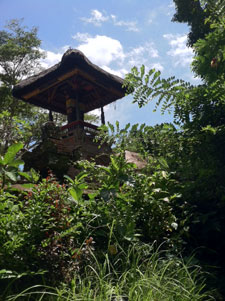 I’ll always associate my first trip to Vietnam with Andrew Pham’s revelatory memoir Catfish and Mandala. Another favorite book of mine—No Mercy, Redmond O’Hanlon’s brilliantly strange account of searching for a lost dinosaur in the Congo—has colored everything I’ve read since about central Africa. The time I spent in Catalonian Spain is forever hooked to art critic Robert Hughes’s Barcelona.
I’ll always associate my first trip to Vietnam with Andrew Pham’s revelatory memoir Catfish and Mandala. Another favorite book of mine—No Mercy, Redmond O’Hanlon’s brilliantly strange account of searching for a lost dinosaur in the Congo—has colored everything I’ve read since about central Africa. The time I spent in Catalonian Spain is forever hooked to art critic Robert Hughes’s Barcelona.
And this spring in Singapore has been shaped by novelist Catherine Lim’s Miss Seetoh in the World and the work of other Singaporean writers, like Wena Poon and Simon Tay.
Lim’s sensitive title character, for instance, weathers many traumas on this conservative island in the 1990s. The novel is an immersion in Maria Seetoh’s inner life, yet that life has been inexorably shaped by the political history of her country. Here, the inner world of a fictional character provides far more context than a travel guide.
In the opening chapter, Seetoh—an English teacher at a Catholic high school and a recent widow who’s secretly glad to be free of an awful marriage—has taken the unusual step of returning to her maiden name. Lim writes:
‘What was that noise?’ the principal asked, and Miss Seetoh said, her eyes sparkling, ‘The noise of being happy, sir.’
Her new bright world would exclude the judgemental and censorious, the dull and the lackluster, and would be confined to her students, fresh-faced, eager-eyed, pure-minded, in their ridiculous uniforms matched precisely to the pristine sky blue and white colours of the Virgin Mary as she stood in her shrine in the school grounds.”
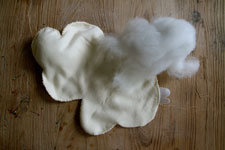
The interior life of fellow humans is what captures my imagination. For readers like me, it’s ironic that places viewed through an author’s words often seem more vivid than the real thing. Yet, I’m not interested in literal interpretations (“that picture looks just like it!”). I want personal perspectives. I want the “why,” which I rarely find in an image.
In the May/June 2012 issue of Talking Writing, we offer many approaches to conjuring a strong sense of place, including those of novelists, essayists, poets, filmmakers, and photographers. It’s a rich and heady mix, with image essays by a range of visual artists—such as the gorgeous photographs of “Icelandic Coastal Waters” by Keith Moul and “Thirty One Kinds of Wonderful,” Singaporean Dawn Ng’s personal take on feeling homesick in Paris.
Some May/June contributors argue that visual images have the most impact. In their essay "Films Convey Reality Better than Words," Marcia Jarmel and Ken Schneider continue a debate I’ve had with them for many years. These documentary filmmakers are now completing Got Balz?, which follows their teenage son Mica’s efforts to donate baseball equipment to children in Cuba. Here’s their take:
A skilled writer could evoke a character visiting a place of personal importance, where the narrative becomes an interior one and the environs speak of the subtleties of local culture. The writer could describe the details in a way that makes us see, hear, and smell the place. But could it be done in a passage that takes only ninety seconds to read?
On the flip side, in “World-Building Martha’s Vineyard,” Susanna Sturgis describes how she used the world-building techniques of science fiction to get beyond the pretty beaches and celebrities. As a result, the novel she wrote about this American tourist mecca portrays much more than a vacation postcard.
Other contributors use words to evoke Jamaica, Bangkok, Russia, the American South—even Boston and my current hometown across the river, here described from an Australian visitor’s perspective.
A sense of place matters in all forms of writing, but in some genres, it’s the key to getting readers to suspend disbelief or to comprehend an otherwise unimaginable situation. In “The Subversive Side of My Personality,” a TW interview with Richard Zimler, the historical mystery writer has this to say about his 2011 novel The Warsaw Anagrams and its early 1940s Polish setting:
The more I read about the Warsaw ghetto, the more it seemed like a ‘Jewish island’ cut off from the rest of the city and the world…. To be confined to an island in the middle of a European capital of one million people seemed to me a unique—and terrible—experience worth writing about.
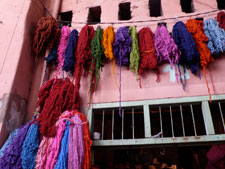 Our May/June spotlight on creative nonfiction comes closest to traditional literary travel writing. In these personal essays, a particular place is not only the topic; an author’s point of view is essential. Are you an insider or an outsider?
Our May/June spotlight on creative nonfiction comes closest to traditional literary travel writing. In these personal essays, a particular place is not only the topic; an author’s point of view is essential. Are you an insider or an outsider?
Travel writing is often done by first-time visitors who make fresh observations, but residents probably conjure the strongest sense of place. In “A Hermit in Chelsea,” for instance, Robert Boucheron brings to life the New York City neighborhood where he lived as a struggling young writer in the 1980s.
In “Sweat and Kiasu in Singapore,” I explore my own competing reactions to living in that island country with my family for four months. While the beauty of nearby Bali may come through with my iPhone snaps, Singapore isn’t well served by pictures of endless apartment high-rises. It’s an oddly appealing place, but its multiculturalism and rapid economic development call for at least a thousand words.
I’m not a photographer, of course. It’s fair to ask whether a visual artist would capture the meaning of the volcano Gunung Agung—which many Balinese believe is the home of gods and ancestral spirits—far more masterfully than I ever could.
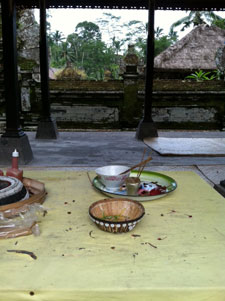 But what caught me on our drive to the Bali airport was the contrast between the sacred mountain and the dirty roads. Our air-conditioned van swung between chickens and old women with baskets on their heads. I was keenly aware of my comparative wealth and outsider status. Before 7 a.m., kids were already on their way to school, wearing uniform blouses and skirts and pants, perched behind motorbike drivers. Few had on helmets. I watched one girl, who seemed unworried about tumbling off, weave shiny ribbons together with both hands.
But what caught me on our drive to the Bali airport was the contrast between the sacred mountain and the dirty roads. Our air-conditioned van swung between chickens and old women with baskets on their heads. I was keenly aware of my comparative wealth and outsider status. Before 7 a.m., kids were already on their way to school, wearing uniform blouses and skirts and pants, perched behind motorbike drivers. Few had on helmets. I watched one girl, who seemed unworried about tumbling off, weave shiny ribbons together with both hands.
That’s when I began to love Bali and to internalize it. I’ll remember it now, rather than relegating it to a forgotten photo album. The contrasts are what Bali—or any place—is about. Beauty and ugliness. Creation and destruction. Freedom and fate.
All artists grapple with these opposing forces when they evoke the world. In Bali, incense is burned daily for the gods on altar ledges; temples are grubby; elaborate carvings in volcanic stone erode but are carved again; small woven baskets with flower petals sit on thresholds, bathroom sinks, Starbucks counters. Daily offerings are scattered on the ground for demons, too, in the form of trash or candy lozenges swarming with ants.
I didn’t like Bali at first, so I didn’t write about it. But heading back to the airport, riding away to another place, I finally wanted to fling my own words at the mountains—to recreate all the worlds inside my head as offerings for something else.
Table of Contents for the May/June 2012 Issue
Publication Information
- Catfish and Mandala: A Two-Wheeled Voyage Through the Landscape and Memory of Vietnam by Andrew X. Pham (Farrar, Straus and Giroux, 1999).
- No Mercy: A Journey into the Heart of the Congo by Redmond O'Hanlon (Knopf, 1997).
- Barcelona by Robert Hughes (Knopf, 1992).
- Miss Seetoh in the World by Catherine Lim (Marshall Cavendish, 2011).
- Telltale: Eleven Stories, edited by Gwee Li Sui, including Wena Poon's "Justin and the Cenotaph" and "The Man Who Was Afraid of ATMs" (Ethos Books, 2010).
- Alien Asian: A Singaporean in America by Simon Tay (Landmark, 1997).
Art Information
- “Rice Paddy,” “Bali Temple,” and “Offerings” © Martha Nichols; used by permission
 Martha Nichols is editor in chief of Talking Writing.
Martha Nichols is editor in chief of Talking Writing.
For more about her time in Singapore this spring, see Martha's Singapore Column ("Kopi, Kaya, and an American Writer").
"Years later, I can still picture the yellow-ochre building outside our apartment, the swifts flitting past, my toddler son’s joy at riding the black horse on the nearby merry-go-round. I don’t just have photographs or neatly organized descriptions; I have images sharpened by strong emotions."—"My Search for Solitude in an Online World"

